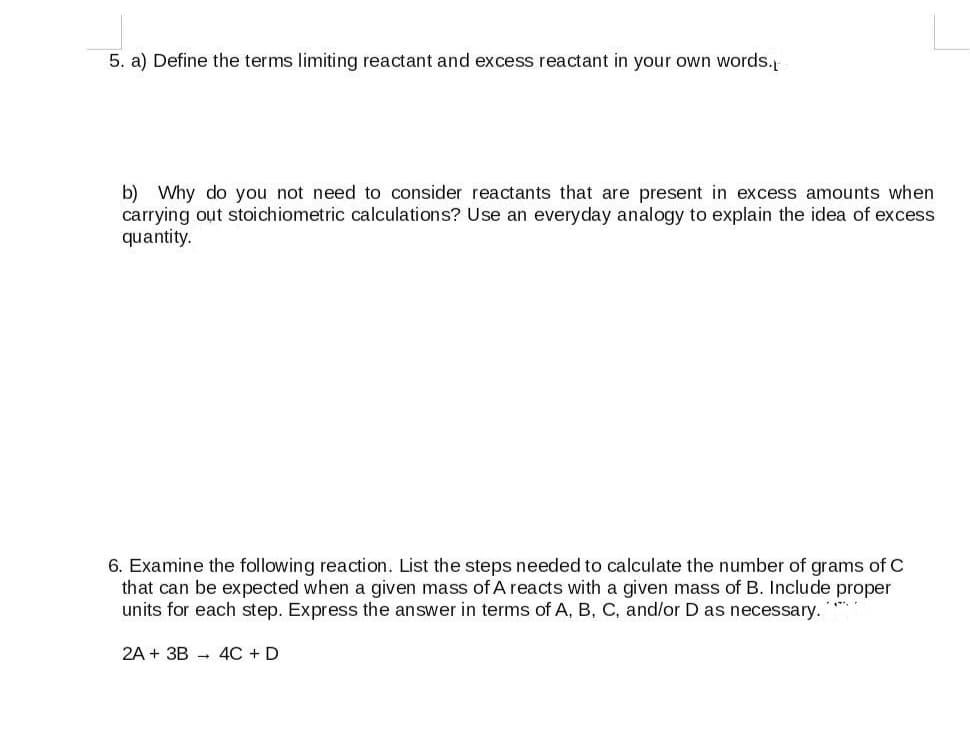5. a) Define the terms limiting reactant and excess reactant in your own words. b) Why do you not need to consider reactants that are present in excess amounts when carrying out stoichiometric calculations? Use an everyday analogy to explain the idea of excess quantity. 6. Examine the following reaction. List the steps needed to calculate the number of grams of C that can be expected when a given mass of A reacts with a given mass of B. Include proper units for each step. Express the answer in terms of A, B, C, and/or D as necessary. 2A + 3B - 4C + D
5. a) Define the terms limiting reactant and excess reactant in your own words. b) Why do you not need to consider reactants that are present in excess amounts when carrying out stoichiometric calculations? Use an everyday analogy to explain the idea of excess quantity. 6. Examine the following reaction. List the steps needed to calculate the number of grams of C that can be expected when a given mass of A reacts with a given mass of B. Include proper units for each step. Express the answer in terms of A, B, C, and/or D as necessary. 2A + 3B - 4C + D
Introductory Chemistry: A Foundation
9th Edition
ISBN:9781337399425
Author:Steven S. Zumdahl, Donald J. DeCoste
Publisher:Steven S. Zumdahl, Donald J. DeCoste
Chapter9: Chemical Quantities
Section: Chapter Questions
Problem 43QAP: Consider the equation: 2A+B5C. If 10.0 g of A reacts with 5.00 g of B. how is the limiting reactant...
Related questions
Question
100%
don't copy from internet or other sources I will downvote I will get to know
need all parts explanation clearly to get upvote

Transcribed Image Text:5. a) Define the terms limiting reactant and excess reactant in your own words.
b) Why do you not need to consider reactants that are present in excess amounts when
carrying out stoichiometric calculations? Use an everyday analogy to explain the idea of excess
quantity.
6. Examine the following reaction. List the steps needed to calculate the number of grams of C
that can be expected when a given mass of A reacts with a given mass of B. Include proper
units for each step. Express the answer in terms of A, B, C, and/or D as necessary.
2A + 3B - 4C + D
Expert Solution
This question has been solved!
Explore an expertly crafted, step-by-step solution for a thorough understanding of key concepts.
This is a popular solution!
Trending now
This is a popular solution!
Step by step
Solved in 3 steps with 3 images

Knowledge Booster
Learn more about
Need a deep-dive on the concept behind this application? Look no further. Learn more about this topic, chemistry and related others by exploring similar questions and additional content below.Recommended textbooks for you

Introductory Chemistry: A Foundation
Chemistry
ISBN:
9781337399425
Author:
Steven S. Zumdahl, Donald J. DeCoste
Publisher:
Cengage Learning

World of Chemistry, 3rd edition
Chemistry
ISBN:
9781133109655
Author:
Steven S. Zumdahl, Susan L. Zumdahl, Donald J. DeCoste
Publisher:
Brooks / Cole / Cengage Learning

Chemistry by OpenStax (2015-05-04)
Chemistry
ISBN:
9781938168390
Author:
Klaus Theopold, Richard H Langley, Paul Flowers, William R. Robinson, Mark Blaser
Publisher:
OpenStax

Introductory Chemistry: A Foundation
Chemistry
ISBN:
9781337399425
Author:
Steven S. Zumdahl, Donald J. DeCoste
Publisher:
Cengage Learning

World of Chemistry, 3rd edition
Chemistry
ISBN:
9781133109655
Author:
Steven S. Zumdahl, Susan L. Zumdahl, Donald J. DeCoste
Publisher:
Brooks / Cole / Cengage Learning

Chemistry by OpenStax (2015-05-04)
Chemistry
ISBN:
9781938168390
Author:
Klaus Theopold, Richard H Langley, Paul Flowers, William R. Robinson, Mark Blaser
Publisher:
OpenStax

Chemistry for Engineering Students
Chemistry
ISBN:
9781285199023
Author:
Lawrence S. Brown, Tom Holme
Publisher:
Cengage Learning

Chemistry: The Molecular Science
Chemistry
ISBN:
9781285199047
Author:
John W. Moore, Conrad L. Stanitski
Publisher:
Cengage Learning

Chemistry: Principles and Reactions
Chemistry
ISBN:
9781305079373
Author:
William L. Masterton, Cecile N. Hurley
Publisher:
Cengage Learning